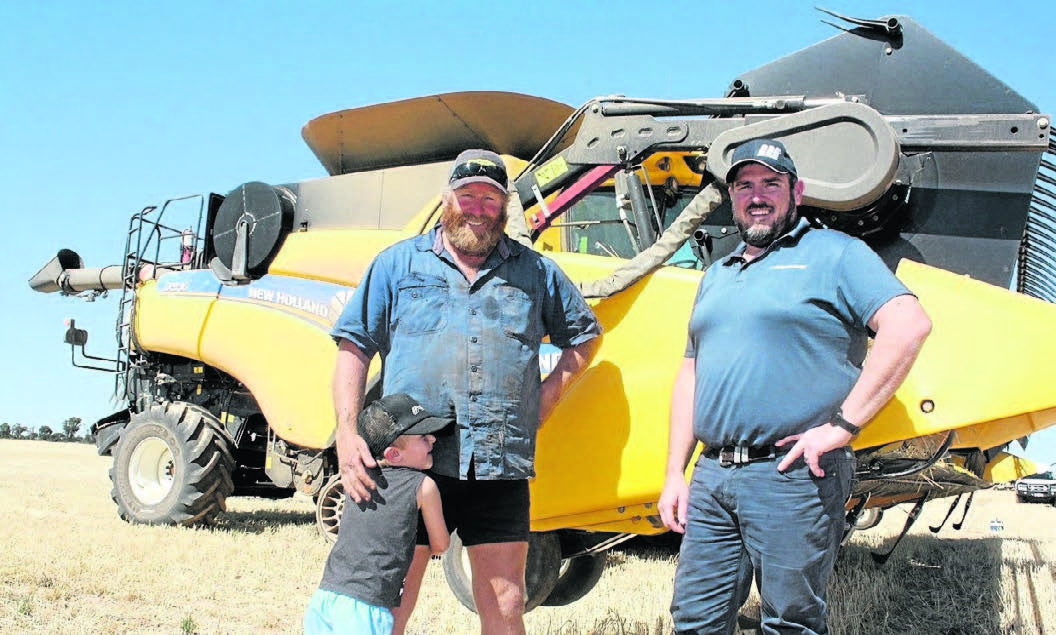

09 April 2020

Wyalkatchem farmer Campbell Jones with his son Jacob next to the new vertical mill mechanical-drive Integrated Harrington Seed Destructor which he says is an improvement on the hydraulic version he used for the previous three years.
WYALKATCHEM farmer Campbell Jones doesn’t mind the description ‘guinea pig’ when discussing the Integrated Harrington Seed Destructor (iHSD).
It was in 2016 he bought a unit, invented by Darkan farmer Ray Harrington, which came with publicity about its ability to achieve a 99 per cent kill rate of targeted weed seeds. “At that stage, it was hydraulic drive and we were the first in our district to try it,” Mr Jones said. “In the first year the main problem was over-heating and the following year we had trouble with the mills and bearings.
“But McIntosh & Son and (South Australian manufacturer) De Bruin Engineering made several changes and last year it worked really well in terms of its operation. “Although I didn’t have the greatest experience with the hydraulic version, I achieved very good results.
“I knew it would destroy the weed seeds and since I’ve been using it we’re getting cleaner paddocks.
“I just persevered with the problems because, to their credit, I got great back-up support from McIntosh. “They had experts come up to sort the problems out, particularly when we had bearing failures. “And when the new vertical mechanical model came out I swapped out of my old header and bought a new CR model with one fitted.
“So far there are no issues and I think the main difference, comparing it to the hydraulic model, is the simplicity of one belt and two bearings. “There’s nothing to check so you don’t have to worry about it.
“The mills are wearing at a rate I reckon will give us 600 hours, even with putting a bit of sand through so I’m happy from that aspect and of course, it’s a lot cheaper than the hydraulic version.
“I reckon guys with two or three headers will be able to afford to get a unit for each of their headers.” But despite the performance of the iHSD, Mr Jones said it was only a tool in the fight against weeds.
“It’s not a silver bullet but it is in with our other strategies which are aimed at reducing weed seed banks,” he said.
The new mechanical vertical mill model uses the same Harrington mill set used in the hydraulically-driven version. Each mill contains a rotor mill and a stator mill which rotate consistently at 3000rpm, which sees weed seeds virtually obliterated as they move through vertical vanes.
The mills only collect the chaff containing the weed seeds off the sieves with straw conventionally fed to choppers or out the back. The vertical mill units are designed to achieve the targeted 3000rpm for optimum performance, allowing the combine to perform to its capacity and not restricted by mill capacity.
Added benefits in the new models include a stone trap; an ability to calibrate a grain loss monitor; more positive material feed into the mills; double flighting on the auger to maintain balance as it wears; heavier duty bearings (rated at 4000rpm); elimination of electrics (except vibration and speed sensors); upgraded pulleys; easier dismantling of the unit and no modifications to the header.
While residue coming out of the mills is like talcum powder, dust is kept under material coming out of the chopper.
“I will probably blow the header down every week whereas with the hydraulic version it was probably every three to four days,” Mr Jones said. With his new CR, Mr Jones said the fitment of tracks to the front axle was a decision he doesn’t regret.
“The tracks are brilliant,” he said. “When you’re on tramlines it helps steady the header so you’re not rocking about when you’re cutting low and that steadies the front to do the job properly.
“I demo’d the same model in 2016 and 2017 and hired one for our last harvest and I was just impressed with its performance. “I like the idea of the twin rotors which seems to produce more efficient threshing to give a cleaner sample with minimal losses out the back.
“We have been sitting on 80 to 85 per cent engine load getting off 1.2 (tonnes a hectare) to 1.3 at 12 kilometres an hour and cutting below beer can height.” Mr Jones also opted for a Cropscan grain analyser to target soil types for prescription mapping leading to variable-rate product application in the future.